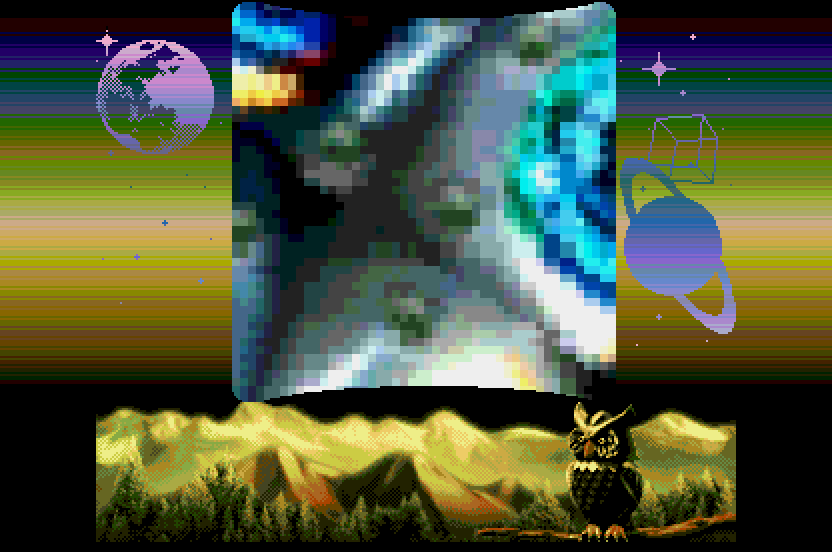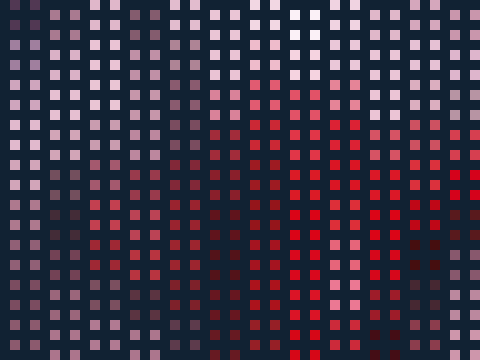Recently there have been a number of rotozoom demos released in what's called truecolour or RGB screenmodes. They got quite large of 4x4 pixel blocks on screen and many of them look quite different from the others.
Atariscne.Org decided to have a look at the phenomenom a bit closer to see what's happening behind the scenes.

Back story
In 2016, nine years back, Photon of Scoopex released what he claimed was the widest 4x4 RGB ”copper chunky” possible on Amiga 500. That was 50 columns of four pixels each, showing a 200 pixels wide truecolour screen with a rotozoomer effect.
The years passed by without any improvement on the technique. Dead Hackers Society and SMFX made an attempt on the humble Atari ST in the Darwins Dilemma demo (2020). The effect was just 48 columns, or 192 pixels wide. And that was not due to lack of trying. We needed quite a bit of fliddling before landing at 48 columns.
In the Amiga world, seven years after Photons demo finally there there’s a new attempt to make a wider 4x4 copper chunky. Blueberry of Loonies somehow broke past Photons claims and displayed 54 columns, or 216 pixels wide on screen. And here it sort of escalated with many new records, within the "copper chunky" technique and even more expanding past it. People are racing the beam with the CPU on Amiga (that is very uncommon) to push colours with the CPU in parallell with the copper. Others are using undocumented HAM7 mode. Some are using sprites and even splitting between HAM and planar modes in the middle of scanlines.
The new Atari records
So what’s happening in Atari land? The old Darwins Dilemma screen can’t be the final frontier, can it? Well, inspired by the incredible Amiga race, the Nordlicht 2025 party saw a release by the mysterious ”Django The Bastard” called The Joker is a Knobhead. It claims to show 80 columns (320 pixels wide on screen) on plain Atari ST! Holy crap, such a slaughter of DHS and SMFX old demo, hats off to Django!
It took a week, and Dead Hackers Society couldn’t stand still and worked on expanding Djangos tech to use STe hardware. Expanding on 80 columns means overscan is required. The STe can do up to 336 pixels (84 columns) without much effort. However, the goal was to go past the Amiga 500 max overscan (376 pixels) so Gigabates can't ever beat it on the A500 (sorry mate :-)).
Anyway it means doing overscan the hard ward, with synchronized vertical frequency switches every scanline. Luckily the STe is slightly less involved than the ST as the end-of-line stabilization can be avoided. After all the colours have been set and borders opened, there’s no CPU left on the truecolour scanlines to do any effect. We’re out of both cycles and CPU registers.
We managed to do 100 columns with the Django method, that’s 400 pixels on screen. The chunky height of the effect is 40 lines, 160 scanlines on screen. All CPU cycles of these 160 scanlines are gone, with some additional overhead (demosystem, music player, hardsync, text writer) there’s about 164 scanlines used out of 313 (52.4%). In other words, less than half a frame left to do the rotozoom effect.
Behind the scenes
So what actually happened here, how could Django and DHS suddenly blow past 48 columns with such a big margin?
Well, by cheating. Sort of. Bending the rules is perhaps a better way of saying it.
Let’s start by looking at a screenshot of Darwins Dilemma with 48 columns.

Nice chunky 4x4 blocks there, if you would count them there are 48*50 blocks. This is exactly how the Amiga copper-chunky records look as well.
Now let’s see the recent Django and DHS attempts.

Ok, something’s obviously off, we’re not seeing the solid 4x4 blocks from Darwins Dilemma.
We need to inspect closer. So let’s remove the raster colours!

Here’s Darwins Dilemma again, as expected we see clean four pixel wide columns using 14 bitmap colours, the bitmap columns repeat fully three times (to 42 columns) then the fourth repeat is just six colours, for a total of 48 columns . The 15th bitmap colour is used for the decorating graphics surrounding the effect and the background colour makes a shade. Top and lower borders are removed, not the side borders.

Joker is a Knobhead by Django The Bastard. By removing the rasters we see that actually the columns are 8px wide, not 4! What the f.. Again, 14 bitmap colours are used and they repeat twice, then the third repetition only does 12 colours, 40 in total, not the claimed 80! There are no borders removed. We can also see that the scroller runs over two different bitplanes. Without looking at the code, we assume bitplane 4+1 to enable longword writes.

The Extended Knobhead by Dead Hackers Society builds on the Django technique. The first 41 colours share the same bitmap colour, thanks to the blitter being able to push a new colour every 8th pixel. Then towards the end of the line, there are nine colours for a total of 50 colours per line. Those final nine colours are set by CPU early far out in the left border. The blitter has to be stopped after 41 colours to make way for opening the right border, that's why there’s a need for the nine CPU-colours.
The cheat/bending of the rules
Looking closely at a section of the truecolour display, switching between a proper 4x4 block and the one we see in both the Django and DHS prods reveals what’s going on without much doubt.

The purple/blue background acts as a mask to hide the fact that colour switches are eight pixels wide. The colours on line one and line two are different; one of them have the even texture colours, the other show the uneven colours.
So all 80/100 effect columns are displayed after all, but using up two scanlines to distribute the colours. The colours are repeated once to make a block of four lines.
Conclusion
The five year old Darwins Dilemma is still the widest real 4x4 truecolour on plain Atari ST. Can it be improved? Likely. But we don’t think there’s a lot of headroom left.
Django The Bastard turned the rules around to give an illusion of 80 columns, quite clever! DHS just did the same and expanded it for STe hardware, allowing a wider screen, mostly thanks to the blitter, but also by using an STe-exclusive overscan method.
DHS claimed that their screen couldn’t be matched on Amiga 500. Which is actually true, though only because the Atari ST/e have narrower pixels and hence can fit more in a line. The Amiga 500 maxes out at 376 pixels while the overscan in the DHS screen is 408 pixels wide.
But wait, 408, not 400? Yes there is theoretical room for two more columns on the STe!
In the end, on both the Atari ST and Amiga the rules have been bent to allow more columns. The current HAM7 record on Amiga gives blurry 4x4 blocks, the Django method on Atari is.. different. Neither can claim to be proper 4x4 truecolour blocks any longer.
Some videos from the above mentioned Atari demos
Darwins Dilemma, 4x4 truecolour rotozoom screen starts at 4m7s into the clip
The Joker is a Knobhead by Django The Bastard, showing 80 columns on plain Atari ST
Extended Knobhead by Dead Hackers Society, showing 100 columns on STe
💾 Download and comment on The Joker is a Knobhead at Pouet
💾 Download and comment on The Joker is a Knobhead at Demozoo
💾 Download and comment on Extended Knobhead at Pouet
💾 Download and comment on Extended Knobhead at Demozoo





Comments
Is it me, or has Evil become more active since the burden of running dhs.nu has been taken off his shoulders?
Very happy to see it, thanks Evil!
As a truecolour display of course it counts :) Looking at the screen it seems like has removed 16px of the left border with the STe-trick. And if I count correctly, the blocks are 6px wide (90px for all 15 bitmap colours before they repeat). So it's a nice truecolour screen, but it doesn't quite fit the 4x4 race.
Correct me if I'm wrong :)
ILLUSIONS UNPACKED FOR A NEW AUDIENCE.
PIXELS BETWIXT PIXELS,
AS THE AMIGA SCENE VOYEURS
RUB EYES IN FRUSTRATION.